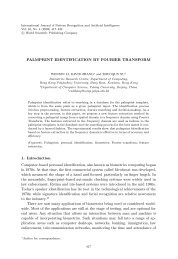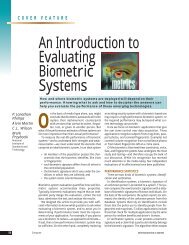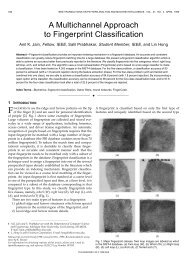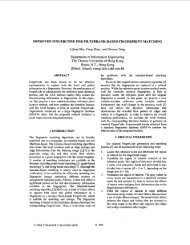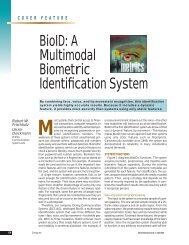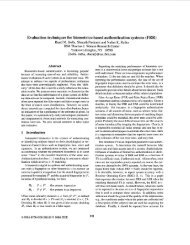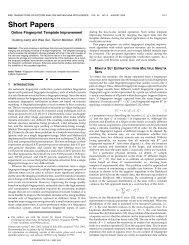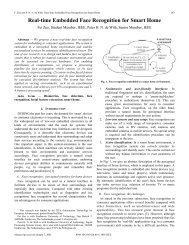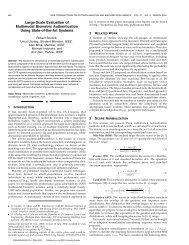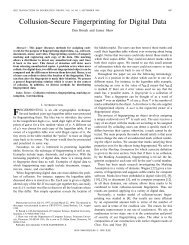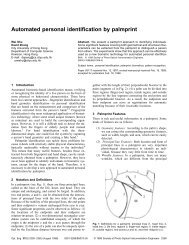Fingerprint indexing based on novel features of minutiae triplets ...
Fingerprint indexing based on novel features of minutiae triplets ...
Fingerprint indexing based on novel features of minutiae triplets ...
You also want an ePaper? Increase the reach of your titles
YUMPU automatically turns print PDFs into web optimized ePapers that Google loves.
620 IEEE TRANSACTIONS ON PATTERN ANALYSIS AND MACHINE INTELLIGENCE, VOL. 25, NO. 5, MAY 2003Fig. 5. Sample images: (a) data set 1 and (b) data set 2.Fig. 8. ROC justifies T ¼ 20.Fig. 6. CIP <strong>of</strong> data set 1.(47.8 percent). The data set 2 is the NIST special database 4 (NIST-4)[9] that c<strong>on</strong>tains 2,000 pairs <strong>of</strong> images. Since these images arecollected with an ink <str<strong>on</strong>g>based</str<strong>on</strong>g> method, a large number <strong>of</strong> NIST-4images are <strong>of</strong> much poorer quality. NIST-4 images <strong>of</strong>ten c<strong>on</strong>tainother objects, such as characters and handwritten lines (see Fig. 5b).The size <strong>of</strong> these images is 480 512 pixels with the resoluti<strong>on</strong> <strong>of</strong> 500DPI. Parameters , , and are different for the two data sets: fordata set 1, ¼ 5 o , ¼ 20 pixels, ¼ 10 pixels, for data set 2, ¼ 10 o , ¼ 40 pixels, ¼ 20 pixels. All other parameters are thesame for both data sets: m ¼ 30 o , l ¼ 30 o ; r ¼ 30 o , t ¼ 50 pixels,T 1 ¼ 4 o , T 2 ¼ 4 o , and T ¼ 20.4.2 Performance Evaluati<strong>on</strong> Measures for IndexingFalse Positive Rate (FPR) and False Negative Rate (FNR) are usedto evaluate the performance <strong>of</strong> a verificati<strong>on</strong> algorithm [10].However, the goal <strong>of</strong> the <str<strong>on</strong>g>indexing</str<strong>on</strong>g> method in this paper is t<strong>on</strong>arrow down the number <strong>of</strong> hypotheses which need to bec<strong>on</strong>sidered for subsequent verificati<strong>on</strong>. The output <strong>of</strong> an <str<strong>on</strong>g>indexing</str<strong>on</strong>g>algorithm is the set <strong>of</strong> top N hypotheses. If the corresp<strong>on</strong>dingfingerprint is in the list <strong>of</strong> top N hypotheses, we should take the<str<strong>on</strong>g>indexing</str<strong>on</strong>g> result as a correct result. Hence, FPR and FNR are notsuitable for evaluating the results <strong>of</strong> an <str<strong>on</strong>g>indexing</str<strong>on</strong>g> algorithm. Wedefine Correct Index Power (CIP) and Correct Reject Power (CRP)as the performance evaluati<strong>on</strong> measures for <str<strong>on</strong>g>indexing</str<strong>on</strong>g>: CIP ¼ðN ci =N d Þ100% and CRP ¼ðN cr =N s Þ100%, where N ci is theFig. 9. Number <strong>of</strong> corresp<strong>on</strong>ding triangles <strong>of</strong> the 2,000 query images <strong>of</strong> data set 2.number <strong>of</strong> correctly indexed images, N d is the number <strong>of</strong> images inthe database, N cr is the number <strong>of</strong> correctly rejected images, N s isthe number <strong>of</strong> the query images that d<strong>on</strong>’t have corresp<strong>on</strong>dingimages in database.4.3 Indexing Results for Data Set 1Fig. 6 shows the CIP for each class <strong>of</strong> images and the entiredata set 1 with respect to the length <strong>of</strong> the short list <strong>of</strong> hypotheses.The CIP <strong>of</strong> a single hypothesis for good quality images is96.2 percent. As the quality <strong>of</strong> images become worse, the CIPdecreases to 85.5 percent for fair and 83.3 percent for poor images.The average CIP <strong>of</strong> a single hypothesis for the entire database is86.5 percent. The CIP <strong>of</strong> the top 2 hypotheses is 100.0 percent forgood images, and for fair images and poor quality images, the CIP<strong>of</strong> the top five hypotheses are 99.2 percent and 98.0 percent,respectively. For the entire database <strong>of</strong> 400 images, the CIP <strong>of</strong> thetop nine (2.3 percent <strong>of</strong> database) hypotheses is 100.0 percent. Fig. 7shows that <strong>on</strong> data set 1 the performance <strong>of</strong> our approach is betterthan that <strong>of</strong> Germain et al.’s approach. We also evaluated the<str<strong>on</strong>g>indexing</str<strong>on</strong>g> performance <strong>of</strong> our algorithm for the 200 images, whichare not in the database. Our <str<strong>on</strong>g>indexing</str<strong>on</strong>g> algorithm rejected theseimages ðCRP ¼ 100%Þ. Thus, threshold T <str<strong>on</strong>g>based</str<strong>on</strong>g> <strong>on</strong> the analysis <strong>of</strong>Fig. 7. Comparis<strong>on</strong> <strong>of</strong> two approaches.Fig. 10. Distributi<strong>on</strong> <strong>of</strong> corresp<strong>on</strong>ding triangels am<strong>on</strong>g 2,000 query images <strong>of</strong>data set 2.




